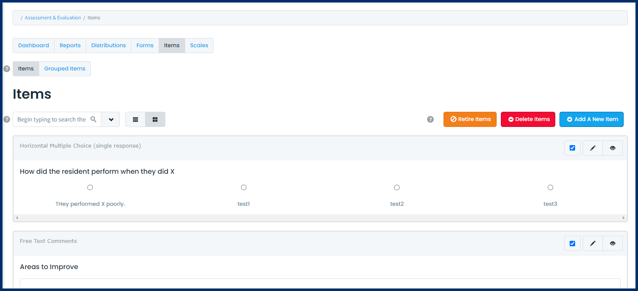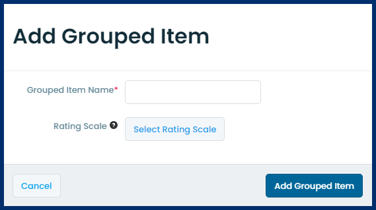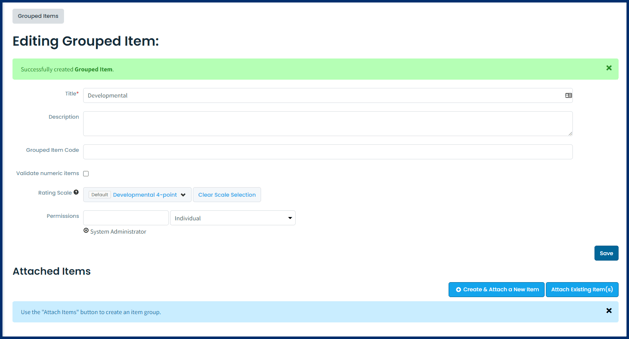Create & Manage Form Items
Create, tag, and add permissions to items for use on forms.
Article Content
This article covers the following topics. Click on the topic to go to that section of the article.
Any forms used for assessment and evaluation require form items (e.g., questions, prompts, etc.). Elentra supports a wide variety of item types, not all of which have the same functionality.
Note: If you are creating items for a form to be attached to a course gradebook assessment for the purpose of online grading using a dropbox, please note that not all item types are supported because there is no structure to weight them on the form added to the gradebook assessment. In such cases, it is recommended that you only use multiple choice, dropdown selector, rubric and scale items (created as group items).
If your form requires narrative comments do not use the free text comment item type, as the grader will not be able to save their comments. Instead, allow or require comments on your scale or rubric items and encourage graders to provide feedback within the rubric or scale item.
Item Overview
To begin, navigate to Admin> Assessment & Evaluation > Forms, then click Add a New Item.
Note: You can copy existing items which may save time. To copy an existing item, click on the item and click Copy Item which is beside the Save button.
Item Type: This list shows the item types supported by Elentra. A complete list is provided below. Your item response options will change depending on your selection.
Item Text: This is what will show up on a form this item is added to. When you view items in the detail view you'll also see the item text.
Item Code: Optional. Item codes display when you view items in a list and they are searchable. Some organizations apply their own coding system to their items, or you may use it as an identifier field for importing items from another tool or vendor with a matching coding system.
Rating Scale: Rating scales can be configured through the Scales tab within Assessment & Evaluation. Select a scale type then the specific scale. Selecting a rating scale will prepopulate the response categories for this item. In some item types you will also be required to add response text (e.g. multiple choice items) and that text will show up on the actual form. In other question types you may rely on just the response categories.
Curriculum Track: Optional. Assign the form item to a particular track(s).
Mandatory: Click this checkbox if this item should be mandatory on any forms it is added to. Allow comments: Click this checkbox to enable comments to be added when a user responds to this item. If enabled, you have several options to control commenting.
- Comments are optional will allow optional commenting for any response given on this item.
- Require comments for any response will require a comment for any response given on this item.
- Require comments for a prompted response means that for any response where you check off the box in the Prompt column, a user will be required to comment if they select that response.
Allow for a default value: If enabled, you must select a default response that will prepopulate a response when this item is used on any form. Set a default response by clicking on the appropriate response line in the Default column.
Permissions: Much like scales, when applying permissions, you are granting the users in that organization or course whose profile provides them with access to use forms, the ability to use this form. You are not providing edit access to every person associated with the organization or course, just those whose profiles give them permission to use forms.
Some item types will have fields for prompted responses. Read about prompted responses in our
Knowledge Base article for more details.
Prompt: This sets a flag on the response option that allows Elentra to send email notifications to users when that response option is selected when someone answers that item on a task.
Prompt Question: If you have enabled "Allow comments for this item" for prompted responses, the Prompt Question text will display above the comment box instead of the word "Comments".
Item Types
Horizontal Multiple Choice (single response): Answer options will display horizontally on the form and the user can select one answer. Response text required; response category optional. Response descriptors provide another data point so you can potentially report on them in the future. They are metadata in MC questions whereas in a rubric they are displayed. Horizontal MC will let you assign the same response descriptors to multiple responses
Vertical Multiple Choice (single response): Answer options will display in a vertical list on the form and the user can select one answer. Response text required; response category optional.
Drop Down (single response): answer options will display in a dropdown menu. Response text required; response category optional.
Horizontal Multiple Choice (multiple responses): Answer options will display horizontally on the form and the user can select two or more answers. Response text required; response category optional.
Vertical Multiple Choice (multiple responses): Answer options will display in a vertical list on the form and the user can select two or more answers. Response text required; response category optional.
Drop Down (multiple responses): Answer options will display in a dropdown list that remains open and allows users to select multiple responses using the control or command and enter/return keys.
Free Text Comments: Use this item type to ask an open ended question requiring a written response.
Date Selector: Use this item type to ask a question to which the response is a specific date (e.g. What was the date of this encounter?)
Numeric Field: Use this item type to ask a question to which the response is a numeric value (e.g. How tall are you?)
Rubric Attribute (single response): Use this to create an item that relies on response categories as answer options. If you enter text in the response text area it will not show up to the user unless you create a grouped item. If you create a grouped item remember you need to use the same scale across all items to be grouped together. If you want a rubric item to display response text, create a grouped item with just one item included.
Scale Item (single response): Use this to create an item that relies on response categories as answer options. If you enter text in the response text area it will not show up to the user unless you create a grouped item. If you create a grouped item remember you need to use the same scale across all items to be grouped together.
Autocomplete (multiple responses): Use this item to allow users to search the option list in an autocomplete fashion and then make multiple selections. The response options will display in the order they were added to the item and when a user begins to type a response, the list of options will be filtered. The user can select more than one response as needed.
Field Note: This item type was developed specifically for post-graduate family medicine prior to the current work on they dynamic competency based education tools.
- To begin you select a curriculum tag set.
- For a tag you want to be available to be assessed on a form, you add 4 response descriptors (e.g., Excellent, Needs Improvement) and corresponding level of competency descriptions.
- If you have a hierarchical curriculum tag set you can develop items for the bottom/most granular tags in the set.
- When you create an assessment form, you can add the relevant curriculum tag set to the form. When individuals use the form they can navigate through the tag set and select the appropriate tag to assess.
Rubric Numeric Validator: This item helps support validated numeric grouped items. You do not need to create any specific items using this item type; rubric numeric validator items can be configured using a checkbox on the grouped item screen (more detail below).
Confidential Free Text Comments: Similar to Free Text Comments, this item type allows the assessor/evaluator to type in text feedback. The response text provided in these items will not display to the target of the form. Medtech & Staff Admin users will be able to view the responses in the Admin A&E tools and reports. Staff:PCoordinators and Faculty:Director users will also be able to view the confidential responses in the Admin A&E tools for distributions they have been permissioned to.
Note: Confidential Free Text Comment item text will display to targets, if the distribution has permitted the target to generate reports on the distribution responses. This means that targets will see what the Item Text of the form item as configured by the administrator who built the item; however, no responses will be displayed.
Tag A&E Items
When creating or editing a form item, below the form configuration options, you will find the area for adding curriculum tags.
If you have access to multiple courses, you can use the course filter to narrow down the curriculum tags available to just those tagged to the course. Click the down arrow beside the course selector and select the course to filter by.
Click through the hierarchy of tags as needed until you can select the one(s) appropriate for the item. As you add curriculum tags, what you select will be listed under the Associated Curriculum Tags section. Click Save to complete.
Create Grouped Items
Creating a grouped item allows you to group items with a common scale for use on forms. If you use the rubric attribute or scale item item types, creating a grouped item will create a rubric with common response categories (e.g. developing, achieved) and specific response text for each field (e.g. performed a physical exam with 1-2 prompts from supervisor, independently performed a physical exam). There is also the ability to Copy a Grouped Item which is next to the Create & Attach a New Item and Attach Existing Item(s) buttons. You can choose to create a new item linkage to keep all items as grouped or to create new individual items from the original grouped item.
To begin click on Admin> Assessment & Evaluation> Items> Grouped Items subtab. Click on Add a New Grouped Item.
Enter your group name and select the rating scale which will be used. Click Add Grouped Item to continue.
Optionally, fill in a group description and group item code.
Validate numeric items: Check this box if you plan to use multiple numeric items that add up to a total you want to validate. (See more detail below.)
Rating Scale: This was selected on the previous screen.
Permissions: Adding a group, course, or individual here will give those users access the the grouped item if their Elentra group and role gives them permission to use forms.
Next, attach items to the group. You can attach existing items that use the selected scale, or you can create new items with the selected scale and attach them. Click
Save once complete.


If you want to include a grouped item on a form that allows the form user to distribute points/minutes/other numeric values to different items, and have a sum that doesn't exceed a total value (dictated by admin. or by user) you can check off the Validate numeric items box. For example, you may consider a group of items wherein the user can specify the total number of minutes spent on an activity, then sub-divide that total into sub-activities.
When creating a grouped item, check off the validate numeric items box.
Numeric validator title: Give the validator (i.e., the total value Elentra will check items against) a title. This will display as the first item in the grouped item.
- I will define the total: This lets the item creator define the total for every time this item is used. The group will require the total to be entered in the Numeric total field.
- The user completing the form will define the total: This will allow the user to create their own total each time they use this item.
Use the item on a form as you normally would. Remember you may need to provide instruction to you users on how to complete the item.
Retiring & Deleting Items

From within the Items tab, use the selector box on items, then the Retire or Delete Forms buttons, respectively.
Retiring items allows a user to manage archived and future or currently active items effectively. When users create forms they will not see retire items, however retired items will still be included in all relevant reports. Retired items will continue show in the item bank, but will have their item type highlighted red.







